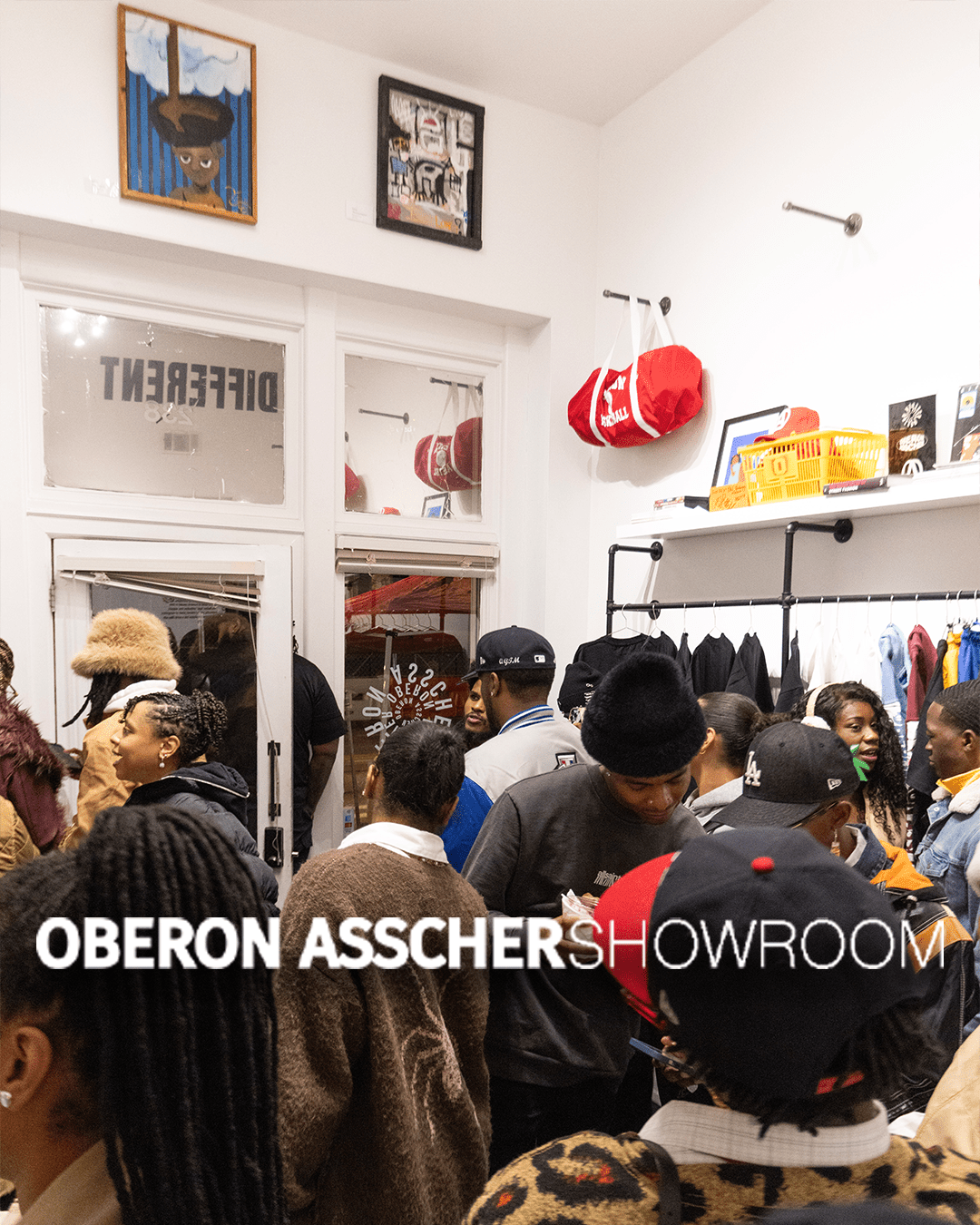OBERON SHOWROOM: THE RADIANT TOPIC BY TELL BEALL

This past weekend, Radiant Topic brought together art lovers, creatives, and the community for an unforgettable night at Oberon Asscher. Despite the freezing temperatures, those who attended experienced the vibrant world of Tell Beall, whose work captivated everyone in the space. For those who couldn't make it, the exhibit is still open for viewing Thursday - Sunday, 12-6 PM.
In this blog post, we’re sharing some highlights from the event, along with a link to the full photo gallery so you can relive the night. Additionally, we sat down for an exclusive coversation between Tell Beall and Sofia Akali, diving into the inspirations behind the exhibit, the creative process, and what’s next for the artist.
And don’t forget—our limited edition Radiant Topic exhibit shirts are still available online! Shop here.
Stay tuned, and keep creating.
Q. Can you tell me a little about your upbringing and how being from Augusta, Georgia has shaped the way you create art?
A. My upbringing involved a lot of playing outside with my brothers and cousins, on a
street full of family and kids. My brothers and I loved video games, but I was really into
sports in Augusta. Prior to the art, I played football, which I’d consider my first love.
It wasn’t much art influence coming up. The close I got to that was music. Learning how
to play drums, being part of the church choir since I was about four. My mom has a
crazy CD collection and I vividly remember the engaging with the music as a child. I
loved how the stories were told through music, too. Being from Augusta, our biggest
influence was James Brown. I would hear my grandma always talking about how “James
Brown was a bad boy”.
When I was in elementary school, me and a couple kids would draw in the mornings,
getting inspiration from the Sports Illustrated Magazines. My mom ended up getting me
a sketch pad, and I vividly remember bringing it to class to show our drawings.
In middle school, I had a homie in my neighborhood. He was a rapper and had a camera, too. So, we would flick each other up in the neighborhood. I would help him with his music videos and ended up doing that for some time.
High school came and I wanted to do YouTube. As a junior, I was gifted a Canon Elph 180 for Christmas and that’s where things took off. I was told about how good my eye was as a youngin’, and that gave me confirmation that I’m talented in something outside of academics or football.
Q. In a previous interview, you mentioned a book about Jean-Michel Basquiat playing a significant role in your artistic journey. Can you remind me of the title of that book? What details of his story inspired you the most?
A. It was Jean-Michel Basquiat and the Art of Storytelling. Being young and successful,
he is a pivotal moment in time when we’re talking about the history of art and black
people. I love his declarative designs, the crossing out of words, numbers and phrases.
This invited viewers to think beyond the surface level of art interpretation. I admire his
story-telling, exploring into the entire subject matter of what he’s working with. Just
look at his work. I believe a lot of Basquiat fans resonate with his child-like expressions. We are all digging for the expression of a youthful, boundless sou. Now that we have so many “distractions”, we’ve subconsciously integrated them into our everyday lives. As a
result, a lot of us feel disconnected from one another. I love that he embraced
vulnerability. He’s made it easier for us to be comfortable with who we are — be open-minded and adventurous instead of stressing over complexity or having things done “a
certain way”.
Q. Are there any other artists that have inspired or influenced your artistic expression?
A. One of homies, Brill Adium, love his intention and subject matter. Groovy, he’s very
innovative. You can really see how experimental he is in his art. I’ve been watching this
one guy on YouTube, Micah. CM Parker, his subject matter is very unique. I recently met
with Stacey Brown and I love what he is doing with glass.
I love when artists don’t take a traditional route. It’s a less traveled path, so I can really
sense an artist’s perspective, style, and language.
Q. Your piece Welcome to Soul City (2024) is a complex and striking mixed media work. I’m curious to know more about your approach to art accessibility in your pricing. We live in a time where art as seen as an exclusive commodity. How do you balance the need to make your work accessible to a wide audience, while also ensuring that it reflects its true value and impact?
A. Artists in Europe were granted studios and spaces to be able to express how they felt in an artistic manner. Most artists were either on drugs or without housing. When it
comes to pricing my work while also being realistic about the state of the economy, I
want to make sure that my work is remains accessible. Also, my art will appreciate over
time. The art will do the work on its own as my work gains more engagement.
Thinking of myself at the studio and of course I’m expressing and throwing up on a
canvas! But there’s a gift to each soul out here. The money comes with the impact. The
artists are the value. As I evolve, the ticket will go up. As an emerging art collector’s
generation is brewing, this is the time to get your investment in. Some pieces don’t have no choice but to be priced at a certain point.
Q. Are there any common themes or societal issues that you find consistently exploring in your work? What do you hope viewers take away or reflect on when they engage with your art?
A. The same common theme we see every day but we don’t speak up on. Whether it’s
being too cliqued up where people “can’t sit with us”, the tiring stories of infidelity and
unhealthy black relationships, along with the mistrust of black men and women. Black
people are lacking fellowship right now. For example, it’s been a long time since I’ve had
a family reunion. We aren’t even vulnerable enough to dance in front of one another
freely, because we “may look weird” on Instagram!
I challenge all of today’s norms, which aren’t normal at all. I want viewers to think
beyond a piece’s beauty. As a lesson. A sense of reason. Do research if you don’t know.
My goal is to create a society where we do not oppose our own people. We are so much
powerful and greater than we’re told. They don’t want us to get along.
We can influence fellowship through media. We have a history of self-expression
through, but they aren’t all great examples. What people see, naturally they will follow.
Do the research! I am all for dismantling the lingering hatred in our community. I am
also for creating more positive black imagery for us and generations to come so that my kids, and my kids’ kids don’t have to fall victim to being labeled, as it’s trending now, a YN.
Q. I understand you're a co-founder of The Archive. Could you tell me more about its mission and how it serves as a safe space for young artists, while also providing access to essential educational resources in the creative realm? How do you envision The Archive influencing the next generation of creators in Atlanta and beyond?
A. The Archive was created to foster the youth, particularly middle-high schoolers, into
learning more about their individual self, discovering creative career opportunities. The
Archive provides a safe space for creative expression and individuality within our youth
from middle schoolers to rising college students. We do this by hosting fun creative
workshops and informative panels, creating educational content, and providing hands on experiences for students interested in art and creative career education in their desired creative endeavors among like-minded peers.
We finished off the year partnering with the 411 Brand, running at 10 Week Mass
Medium Curriculum through their program Saturday School. Students produced a variety of final projects in the end with things like creating a short-film from scratch and a photo exhibition where they were able to take their first framed artwork home. We have our second annual art show coming up in March 2025. Last year, we featured more than 20 artists with 100+ attendees, so we are excited to how this year unfolds and the impact we will make.
The next generation will benefit because there will be a strong network within the
creative community. There are a lot of schools in Georgia that are removing art from their programs. Through the Archive, students will be able to sharpen their artistic skills to help mitigate the lack of creative development in schools. In parallel, the archive will teach the importance of individuality, thus strengthening their self-esteem.
Q. What are your thoughts on the current art scene in Atlanta? Do you think the city has potential to become a major art hub like New York, Los Angeles, or Miami? If so, what steps or initiatives would you like to see that will help elevate Atlanta’s art presence on a national or global scale?
A. It’s growing! I’m loving what I’m seeing actually! And I believe so. The more we become engulfed in appreciating art, it’ll continue to grow. We need more black collectors. We have so many dope artists out here. People can invest and grow their portfolio along with current local artists. Together, we can bring this vibrancy to communities, homes, and businesses. Art will heal and benefit us both individually and collectively as a whole.
We’re so much more alike than we all think!
Also — We need to hold art funders accountable to funding artists properly. We also need to ensure that galleries and museums showing up for artists. Let’s diminish the narrative of starving artists and embrace the essence of art and how important it is in our everyday life. Today, there are only 1.2% of Black Artists represented in galleries and museums, it’s time to change that!
Q. As a multidisciplinary artist, you've mentioned your interest in graffiti and cartoons while growing up—can we expect to see these influences play a larger role in your future work? Also, are there any upcoming projects or new mediums you're particularly excited to explore?
A. Maybe. I’m working on building some characters, or making my subjects more cartoony to add a more animated feel to them. I know I want to start doing larger-scale work. I have also been thinking about a series about black boys. I see myself doing murals, as well. Right now, I don’t have anything concrete I’m working on, I’m just flowing between projects. At the moment, I’m working on building recognition so I can create more impact. I want to meet more people. I’m also preparing for some upcoming non-profit work.
Q. How can people stay connected with your work or support your creative journey moving forward?
A. People can stay connected with me on all socials, @thetellbeall or my website
martellbeall.com
Q. Are there any final thoughts or advice you’d like to share with aspiring artists or creatives?
A. Do this for you, you don’t need any validation! Continue to lean more in your craft and people will gravitate to you. Find your tribe. Not everyone will support you like you desire and that’s fine. Just focus on what you enjoy doing, it’s not easy. Also — learn the business side of all this. It’s dope and all to get your work in spaces and sell, but make sure you understand this market and the proper business moves so you can be successful. Something I just recently learned!
Peace & Love.






















Leave a comment